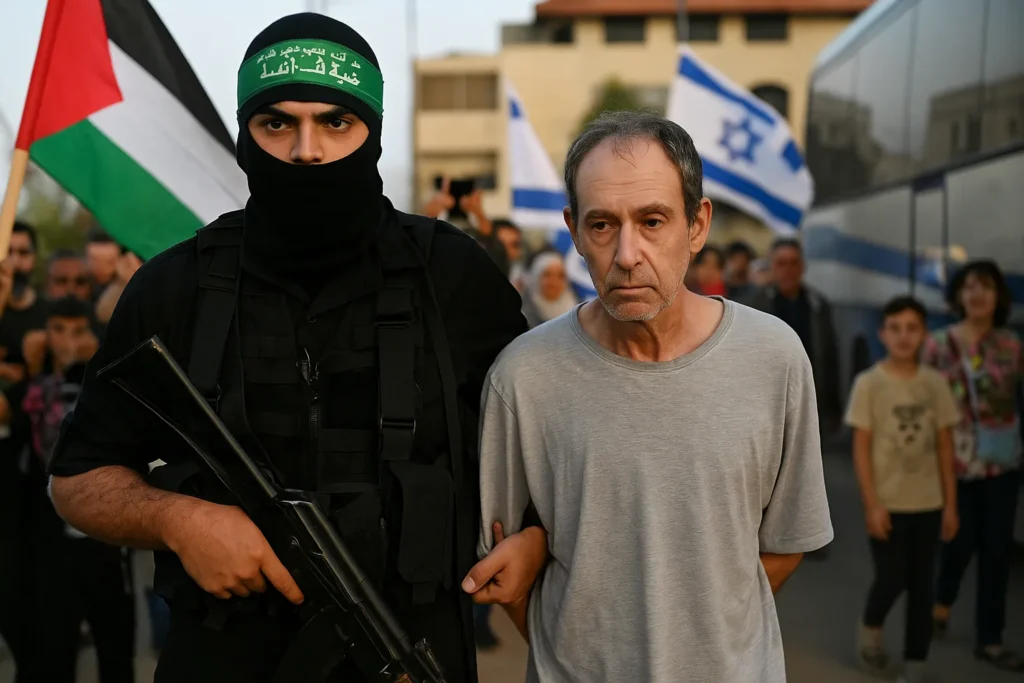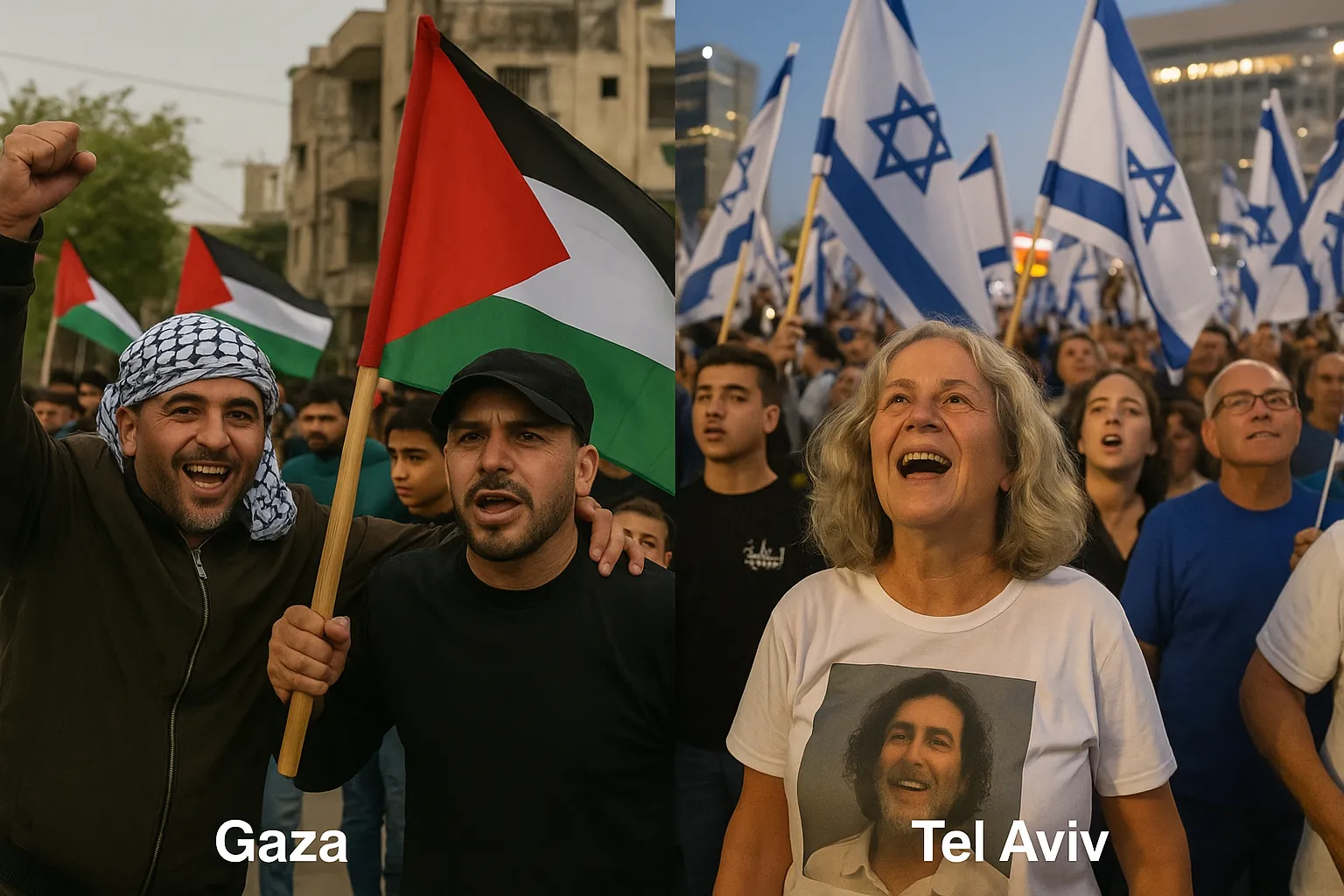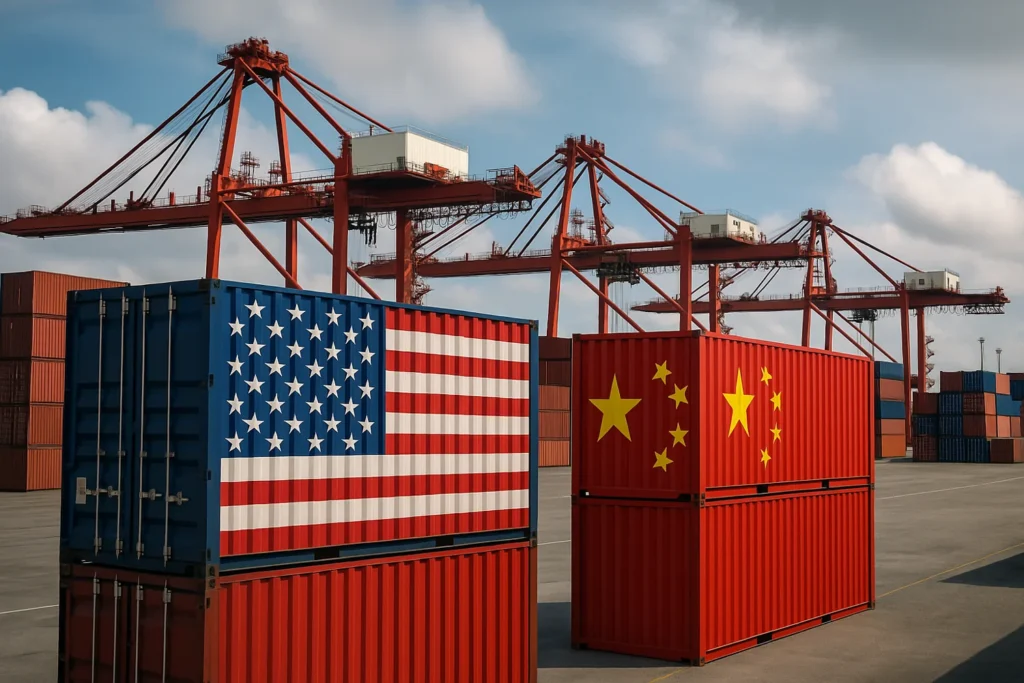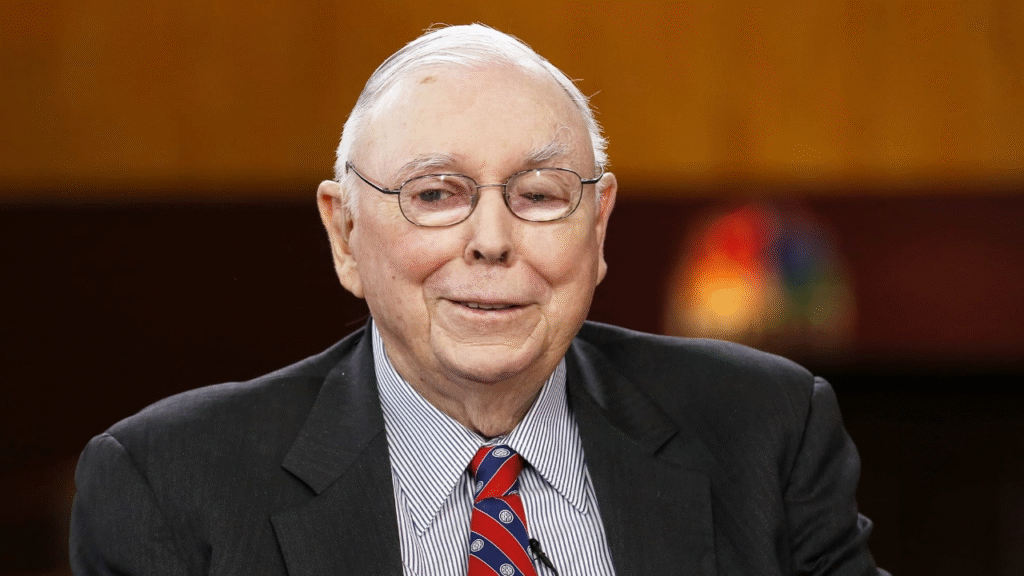The sound of celebration echoed across both Gaza and Tel Aviv, but it was not the sound of peace. When Hamas confirmed the handover of the final Israeli hostages still alive under its control, the announcement was framed as a historic milestone — the successful completion of phase one of the ceasefire deal. Yet beneath the smiles and handshakes, an undeniable truth remained: this fragile truce rests on quicksand.
The Hamas Gaza Hostage Release marks the first major success of an agreement brokered by Egypt, Qatar, and the United States — one that exchanges 2,000 Palestinian prisoners for the last remaining Israeli captives. Two years after the October 7 attacks, the release feels less like reconciliation and more like exhaustion dressed as progress.
Context: Two Years Since the War Began
When the October 7 attacks tore through Israel, they didn’t just spark another Middle East war — they reshaped the entire region’s political geometry. The Israeli response was relentless, reducing entire districts of Gaza to rubble and killing tens of thousands. Gaza’s population was forced to live amid constant bombardment, its hospitals overwhelmed, its schools turned to shelters and graves.
Now, with the guns temporarily silent, both sides are left with the ghosts of what’s been lost. The ceasefire agreement, carefully negotiated behind closed doors, outlines three key stages. The first — the hostage-prisoner exchange — is now complete. The second phase involves humanitarian corridors and limited Israeli withdrawals from Gaza. The third, the most ambitious and uncertain, envisions direct peace talks under international supervision.
But nothing about this process is simple. Even as the final hostages crossed back into Israel, aid convoys were being halted at checkpoints, and Red Crescent teams struggled to reach northern Gaza. For every image of a family reunion, there is another of a mother digging through ruins.
A Deal Built on Distrust
It’s hard to call this a peace agreement when neither side trusts the other. Israel insists the ceasefire is temporary — a pause to recover hostages, not a promise of reconciliation. Hamas views the deal as proof that armed resistance works.
Both narratives are technically true, and that’s what makes this so unstable. In Tel Aviv, Prime Minister Netanyahu faces enormous pressure from a divided public. Families of hostages demand total peace; far-right ministers demand total annihilation of Hamas. In Gaza, the group’s political leadership celebrates “victory” while civilians bury their dead under the banner of liberation.
Trump, the self-proclaimed architect of the ceasefire, called it “a model of strength through negotiation.” But diplomats in Doha and Cairo describe a very different picture — one of chaos, mistrust, and last-minute threats that nearly collapsed the deal. According to an Egyptian mediator, “We were seconds away from failure three times. The hostility on both sides was visceral. They don’t talk peace — they talk survival.”

Analysis: The Economics of Exchange
The 2,000 Palestinian prisoners released by Israel include both long-term detainees and individuals held without trial under “administrative detention.” Human rights organizations estimate that nearly a quarter of them were never formally charged. For Israel, the trade is politically painful but strategically necessary. The return of its citizens plays well domestically, even as critics accuse Netanyahu of “negotiating with terrorists.”
For Hamas, the numbers speak louder. The exchange gives it a narrative of strength — proof to supporters across the Arab world that the movement forced Israel to yield through resistance. In the crowded streets of Khan Younis and Rafah, the returning prisoners were met with chants and flags. Yet behind the spectacle, Gaza remains in ruins. Hospitals still operate without electricity, clean water is scarce, and the UN warns of famine-level food shortages.
This is the paradox of the ceasefire: a symbolic victory built on humanitarian despair. The Hamas Gaza Hostage Release may dominate headlines, but the real question is whether this moment can break the region’s cycle of vengeance.
The Role of International Mediators
The United States, Qatar, and Egypt all claim credit for the breakthrough, but insiders describe a deal stitched together through desperation more than diplomacy. Leaked notes from UN negotiators reveal that Hamas initially demanded 3,000 prisoners and an Israeli withdrawal from northern Gaza — terms Israel refused outright. Only after Washington pressured both sides with financial incentives did the exchange become viable.
Trump’s involvement, though celebrated in his campaign speeches, remains controversial. European diplomats describe his mediation style as “transactional to the extreme.” A senior French official, quoted anonymously, called it “peace by spectacle.”
Still, for families awaiting loved ones, politics is secondary. At an air base outside Tel Aviv, Israeli medical teams greeted freed captives, many showing signs of malnutrition and trauma. One 24-year-old woman told Haaretz that she had “forgotten what silence sounds like.”
The Human Cost in Gaza
On the other side of the border, 2,000 Palestinian families celebrated reunions of their own. For them, the deal is both a personal victory and a bitter reminder of Gaza’s devastation. Among those freed was Amal Zaydan, a teacher imprisoned for nearly four years without trial. Returning to her bombed-out home in Beit Lahia, she described the paradox of freedom amid ruins: “We are free, but Gaza is a prison.”
UNICEF reports that more than 70% of Gaza’s population remains displaced, with makeshift camps stretching from Rafah to Deir al-Balah. While international donors have pledged billions for reconstruction, logistics remain paralyzed. Egyptian engineers have begun preliminary assessments for rebuilding roads and power grids, but experts estimate full reconstruction will take at least a decade.
In this chaos, even a short-lived truce feels miraculous. Yet the fear among Gazans is universal — that Israel will resume strikes the moment phase two negotiations falter.
Counterarguments and Political Games
Not everyone sees the deal as a step toward peace. Israeli opposition figures accuse the government of weakness, claiming that exchanging 2,000 prisoners for fewer than 100 hostages “invites future kidnappings.” They demand a harder line, including the reoccupation of Gaza’s border zones.
In contrast, international observers view Israel’s concessions as pragmatic. The Guardian described it as “the first crack in a wall built on vengeance.” Analysts at the Carnegie Middle East Center argue that the truce could evolve into a semi-permanent arrangement similar to the post-war division of Lebanon in the 1980s — not peace, but a new balance of deterrence.
For Washington, the deal buys breathing room. It allows Trump to brand himself as a peacemaker without solving the underlying crisis. Yet many inside his own administration privately doubt the ceasefire will hold. One senior State Department official reportedly told Politico, “This is more like an intermission than an ending.”
The Regional Domino Effect
The Hamas-Israel exchange has also reshaped regional alliances. Saudi Arabia’s foreign ministry cautiously praised the truce but warned that “peace cannot exist without addressing root causes.” Iran celebrated Hamas’s “victory of resistance” but refrained from escalating tensions — a calculated move to preserve its strategic leverage.
Egypt, meanwhile, emerges as an unexpected power broker. Cairo’s ability to host and mediate complex, high-stakes negotiations has boosted its diplomatic relevance after years of regional decline. Yet Egyptian officials privately fear the deal’s collapse could push another wave of refugees toward their already volatile Sinai border.
The United Nations has called the ceasefire “a humanitarian opening,” but most analysts agree it is temporary. Every actor involved — Hamas, Israel, Trump, and the mediators — has political incentives to claim victory. None can afford the appearance of retreat.
The Emotional Geography of War
In both Tel Aviv and Gaza, grief now lives beside relief. Israeli parents embrace their freed children while still mourning those who never returned. Palestinian mothers prepare food for sons who spent years in prison, even as Israeli drones circle overhead.
The human landscape is one of contradictions — freedom and rubble, silence and anxiety, laughter that ends in tears. The ceasefire has not healed the trauma; it has merely paused its expression.
Psychologists working with both Israeli and Palestinian survivors warn of an impending mental health crisis. “After long trauma,” says Dr. Nitzan Levy of Tel Aviv University, “people don’t just recover. They collapse when the noise stops.”
What Comes Next
Phase two of the ceasefire — the implementation of humanitarian corridors and partial Israeli withdrawals — will test whether this fragile peace can evolve into something real. Negotiations begin in Cairo next week, with U.S. and Qatari officials pressing for verifiable mechanisms to monitor compliance.
But already, cracks are showing. Israeli military sources report renewed skirmishes in the Gaza periphery. Hamas accuses Israel of delaying fuel shipments. Both sides exchange blame even as they prepare for another round of diplomacy.
If the talks hold, the next 60 days could mark the beginning of reconstruction and regional stability. If they fail, the world may witness another cycle of violence even more devastating than before.
For now, the Hamas Gaza Hostage Release stands as the symbolic victory of this uneasy truce — a brief convergence of human compassion amid political calculation. Whether it becomes the foundation of peace or just another pause before the next war depends entirely on choices made behind closed doors.
Conclusion: The Mirage of Peace
History rarely remembers ceasefires — only wars. Yet in this small window of quiet, something extraordinary has happened: Israelis and Palestinians, for the first time in years, are united in exhaustion. They want the killing to stop.
The release of the last hostages is both an ending and a beginning. It ends two years of unimaginable suffering for families torn apart by conflict. It begins a test of political will — a test that few in the region have ever passed.
Trump will claim victory. Netanyahu will claim strength. Hamas will claim resistance. But the truth lies somewhere in the rubble — where real people now try to rebuild lives under a sky that, for the first time in two years, is not on fire.
External Links
103 views






